ISSN ONLINE(2319-8753)PRINT(2347-6710)
ISSN ONLINE(2319-8753)PRINT(2347-6710)
Megha Agarwal1, Animesh Agarwal2
|
| Related article at Pubmed, Scholar Google |
Visit for more related articles at International Journal of Innovative Research in Science, Engineering and Technology
Present study was carried out in river kosi, Rampur district, India to assess the river water pollution for that, six sites are select to collect samples where industrial & domestic waste is regularly mixing in river kosi and by these activities river water become polluted. The samples were analysed to measure the DO, BOD, COD, TS and alkalinity. The collected data were use to statistical analysis and some good correlations (by calculating correlation coefficient r and drawing dotted graph) between parameters are established. The regression equation also established between these parameters to assess the extent of pollution in river kosi. The RPD (Relative percentage difference) value is also calculated and low values of RPD indicate that there is a very small difference between measured and estimated values of parameters. This clearly indicates the validity of regression equation that can used to find the value of one parameter if the value of other is known in same water.
Keywords |
| Physico chemical water parameters, RPD Values, Regression Equation, Correlation Coefficient, River Kosi |
I.INTRODUCTION |
| In the recent few decades, India has seen the large-scale urbanization, industrialisation and technological development. However, progress has accompanied by a growing negative impact on the environment in terms of its pollution and degradation. Unplanned and haphazard industrialisation has substantially increased the risk to the environment. It is evident that pollution from various sources particularly from industries has negative impact on environment, irreversible in nature (Agarwal A, 2013, Agarwal A and Saxena M, 2011, Chindah A C, Braide A S and Sibeudu O C, 2004). A number of studies (Agusa T et. al. 2005, Barbosa A C et.al. 1995, Bulut Y and Baysal Z, 2006, Ogbuagu H D, 1999) have shown that water pollution is taking a heavy toll of human life, particularly, in the developing countries like India through ill health and premature mortality. |
| Throughout history, the quality of drinking water has been a factor in determining human welfare. In some areas, the quality of water is subject to a number of chemical threats. There are many possible sources of chemical contamination. Since World War II, there has been a tremendous growth in the manufacture and use of synthetic chemicals. Many of the chemicals have contaminated water supplies .The industrial revolution resulted in an improving lifestyle, raising the standard of living of people, but also resulted in an indiscriminate exploitation of natural resources. Human activities have put a considerable pressure on the availability of basic human necessities such as clean water and air. Waste water from various industries, municipal corporations, urban and rural runoff, coupled with the increasing use of various chemicals, surfactants, fertilizers, pesticides and herbicides in agriculture and the decomposition of vegetable and animal matter discharge varying amounts of these and other chemicals into ground and surface water, making it unfit for human and animal consumption. |
| Studies have shown many industries are discharging their waste into the rivers. This is attaining hazardous conditions, especially in big cities where the population is large, the demand for water is very high, and industries are developing at a faster rate. Some of the organic and inorganic compounds, when present in water are toxic, carcinogenic and mutagenic, and cause several ailments in humans. Pollution in general and water pollution in particular has attracted the attention of scientific workers (Ugochukwu C N C, 2004, Emongor V 2005) the world over. Among the inorganic contaminants of the river water, heavy metals are getting importance for their nondegradable nature and often accumulate through tropic level causing a deleterious biological effect. Quality of river water is degrading day by day hence there is an acute need of measuring physico chemical parameters of rivers at a regular basis (Waziri M and Ogugbuaja V O, 2010, Sinha, D.K., and Srivastava, A. K., 1995, Sinha, DK et. al 2004). In our study, we are focusing on the river Kosi that is an important river flowing at the foothills of the Kumaon region. The total catchments area of the river is 3420 sq km. Total length of river is 240 km. It originates from spring source at Rudradhari (District Almora, Uttarakhand) and confluences to river Ram Ganga near village Chamraul (Tehsil-Shahabad, District-Rampur, U.P.). The river used for various purposes such as Drinking water source, Irrigation purposes, Washing & Bathing, Fishing, Waste dumping like solid waste, dumping domestic wastewater, industrial wastewater, cremation waste etc. It drains the central part of the Almora district and western part of Nainital District of Uttarakhand. Further, it enters the plains of the western Uttar Pradesh (U.P.) and is spread across Rampur district. District Rampur is located between Longitude 78-0-54 & 69-0-28 East and Latitude 28-25 & 29-10 North. Spread in area of 2367 Sq. Km falls in Moradabad Division of Uttar Pradesh State. District Udham Singh Nagar in North, Bareilly in East, and Moradabad in West and Badaun in South surround it. The height from sea level is 192 Meter in north and 166.4 m in South. Our areas of study of Kosi River mainly lie in the Rampur district. |
| A number of investigators (Agarwal A and Saxena M, 2011, Sinha DK, Saxena S. and Saxena, R., 2004, Ashish Kumar and Yogendra Bahadur, 2009) attempted before to check the quality of rivers water near Rampur district and its physicochemical parameters. However, nobody establish empirical relationship to measure the quality of river kosi. Analytical techniques are used to produce reliable results but generally the laboratory methods are time consuming and very costly. However, some models can develop which will provide easy, reliable and cost effective methods to collect data and provide information of the level of pollution by different parameters. In the present work, an attempt made to analyse quantitatively the physicochemical parameters and to establish a mathematical relation between them. For that, correlation coefficient calculated to understand the nature of correlation between physicochemical parameters and established a regression equation to calculate the water parameters. |
II.MATERIALS AND METHODS |
| Sampling sites & Sampling: Six sampling sites were selected as follows: Dadiyal (S1), Swar (S2), Lalpur (S3), Pranpur (S4), Rampur Kosi Bridge on NH-24 (S5) and Shahabad (S6) .These sites were places from where the reach up to the river kosi was easy (figure-1). Water samples collected at random in triplicate from the six sites at the centre of the river channel. The samples were collected using 500 ml polythene bottles. The bottles thoroughly cleaned in soap solution first, soaked in 10 % hydrochloric acid (HCl) for 24hrs, and then rinsed with distilled water. The bottles further rinsed three times with sample water, immersed about 20 cm below the water surface and filled up to the top. All samples were tightly sealed and kept cool using ordinary dry ice in the field and while on transit to the laboratory. |
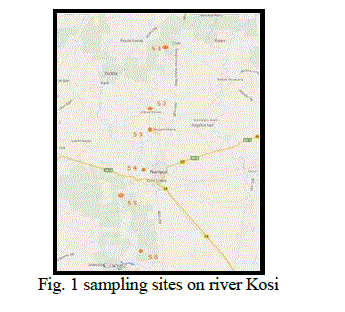 |
| Chemical Analysis: The sample were analysed for physico chemical parameters such as alkalinity, total solid (TS), dissolved oxygen (DO), biological oxygen demand (BOD) and chemical oxygen demand (COD) following standard analytical technique (APHA, AWWA, WPCF 1995). The average values of parameters at each site are summarised in Table-1. |
 |
| Statistical analysis: All the data obtained subjected to statistical analysis. In statistical analysis, a correlation developed between parameters by using KARL PEARSONS Coefficient of correlation and a regression equation is established. |
| Calculation of KARL Pearson’s Coefficient of correlation: |
| Correlation coefficient (r) calculated using Karl Pearson’s coefficient, between each pair of Physico-Chemical water parameters by using the Kosi river data. According to Karl Pearson, coefficient of correlation (r) between two parameters X and Y is calculated as |
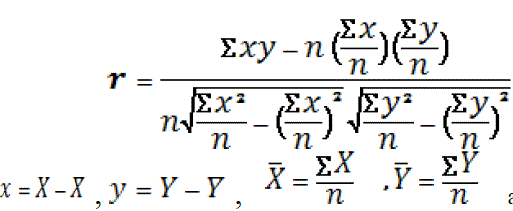 |
| If the value of correlation coefficient (r) between two variables X and Y is large, it implies that these two variables are highly correlated. |
| Calculation of Regression equation: The term regression stands for some sort of functional relationship between two or more related variables. It measures the nature and extent of correlation and predicts the unknown values of one variable from known values of another variable. Following regression equation is used to established correlation between parameters |
 |
| The above equation called regression line equation of Y on X and byx called regression coefficient of Y on X and calculated as |
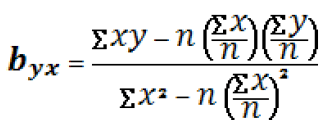 |
| Relative Percentage Difference (RPD value): To check the validity of the regression equation results the measured and estimated values of parameters compared by using RPD value given by Kar P K et. al., 2010. |
III.RESULTS AND DISCUSSION |
| The correlation coefficient shows the extent of association exists between two variables. The greater the value of coefficient indicates a good relationship between two parameters. According to Patil & Patil, 2010, there is a direct relationship exists between two parameters on decrease or increase of one parameter the other will also change. The relationships between the parameters in the form of scatter diagrams are given in fig. 2-5. The regression analysis carried out to relate DO, BOD, COD, alkalinity, and total solids. |
| The relationship between COD with BOD, DO with BOD, DO with COD and TS with alkalinity is established which give correlation coefficient r = 0.8657, r = -0.8795, r = -0.8897 and r = 0.8328 respectively, showing a very good correlation. |
| The increase of industrial & domestic waste in river water decreases the DO level in Indian River. The BOD test measures the amount of oxygen required by microorganism to degrade the organic matter (bio- degradable and nonbio –degradable). High value of BOD indicates a decrease in DO level because oxygen is consumed by aerobic bacteria that make the aquatic life survival difficult. The COD test measures requirement of oxygen by organic and inorganic compounds, it clearly indicate that presence of these compounds also decreases the DO level in river water. A good correlation between DO & BOD and DO & COD confirm the dependence of both on DO. |
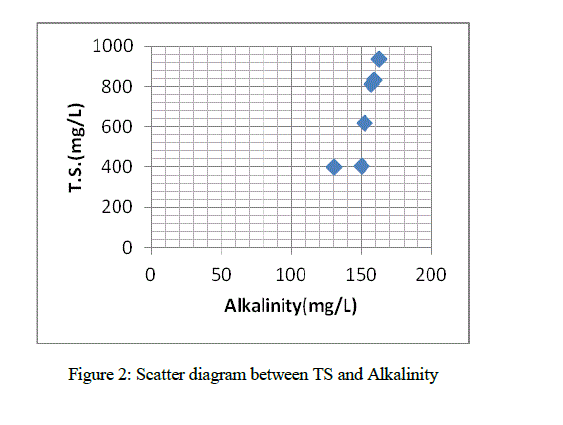 |
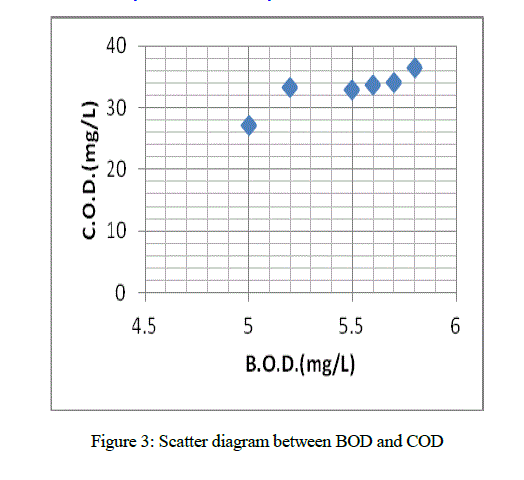 |
| The regression equation DO = -0.8169 BOD + 11.28 & DO = -0.8167 COD + 9.5022 can be used to estimate BOD and COD respectively. The estimated DO values are comparing with measured DO values at site S1 using BOD & COD values the RPD values obtain are 1.47 & 12.5 respectively. It also made easy to find the value of BOD/ COD ratio to analyse the extent of pollution and food value. If the ratio is higher than food value is higher and toxicity is less, because BOD is not due to food organics but it is due to nitrates that are responsible for oxygen depletion. A good correlation between COD and BOD relationship for polluted water estimated by regression equation agrees well with the measured relationship. The regression equation COD = 8.7606 BOD – 15.007 can be used to estimate COD value. The RPD value of COD at site S1 calculated as 1.34.Alkalinity measures the amount of alkaline compounds present in river water such as bicarbonates, carbonates, borates, silicates along with hydroxides. The high value of alkalinity at site S6 indicates that domestic waste and cloth-washing activities occurs at this site. A good correlation obtained between total dissolved solids (TS) and alkalinity. As TS is the measure of the suspended and dissolved solids in water body thus alkalinity &TS regression equation TS = 16.608 alkalinity – 1852.1 can be used to estimate TS value and its RPD value is calculated as 6.74 at site S1 which indicate a very less difference in measured and estimated value. |
IV.CONCLUSION |
| Regression equation can be widely used for establishing some good correlations between physicochemical water parameters and these equations can be used to predict the contamination in river kosi. In present study, we have established four good correlations and derived four different regression equations for the estimation of DO, TDS and COD. The RPD (relative percentage difference) between measured and estimated values found to be very low, indicating validity of the equations. The above analysis is very useful, cost effective and time saving method to get accurate idea of quality of kosi river water. The analysis give us tool to predict the level of pollution by investigating the water parameters and take preventive measures prior to the detailed pollution monitoring of river kosi. |
References |
|